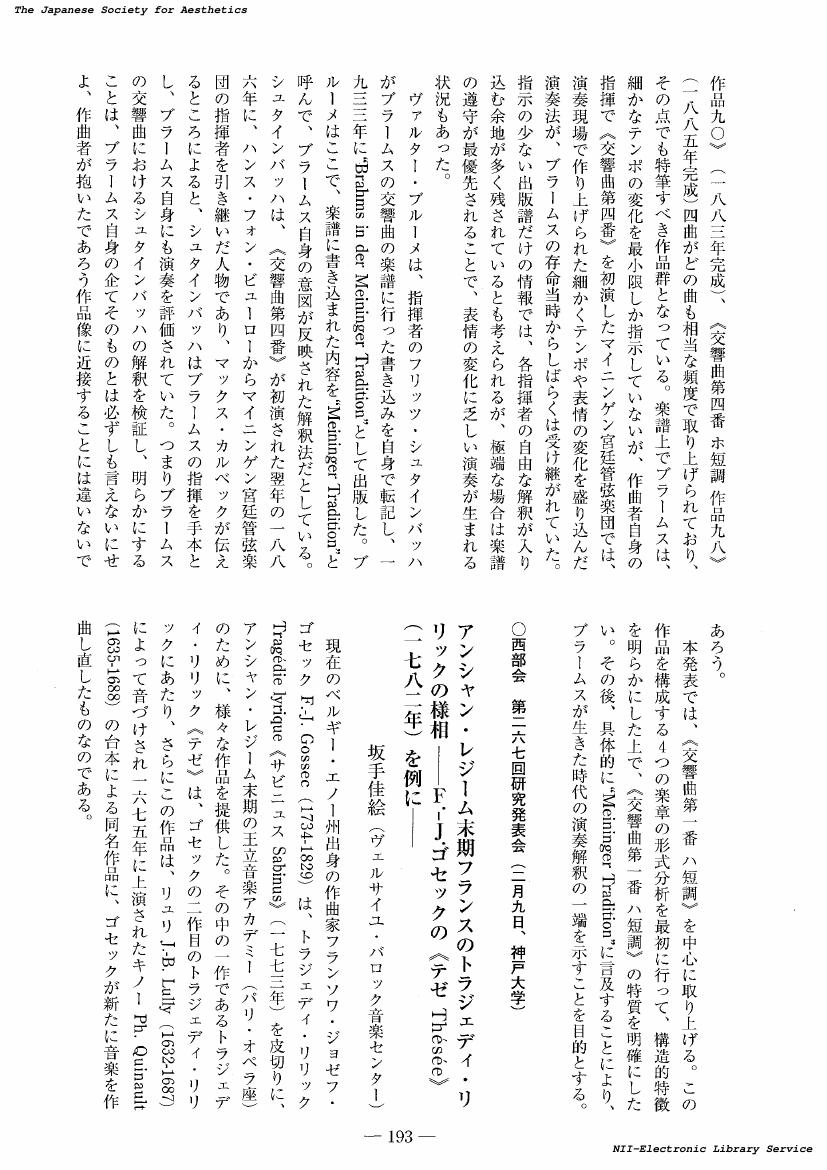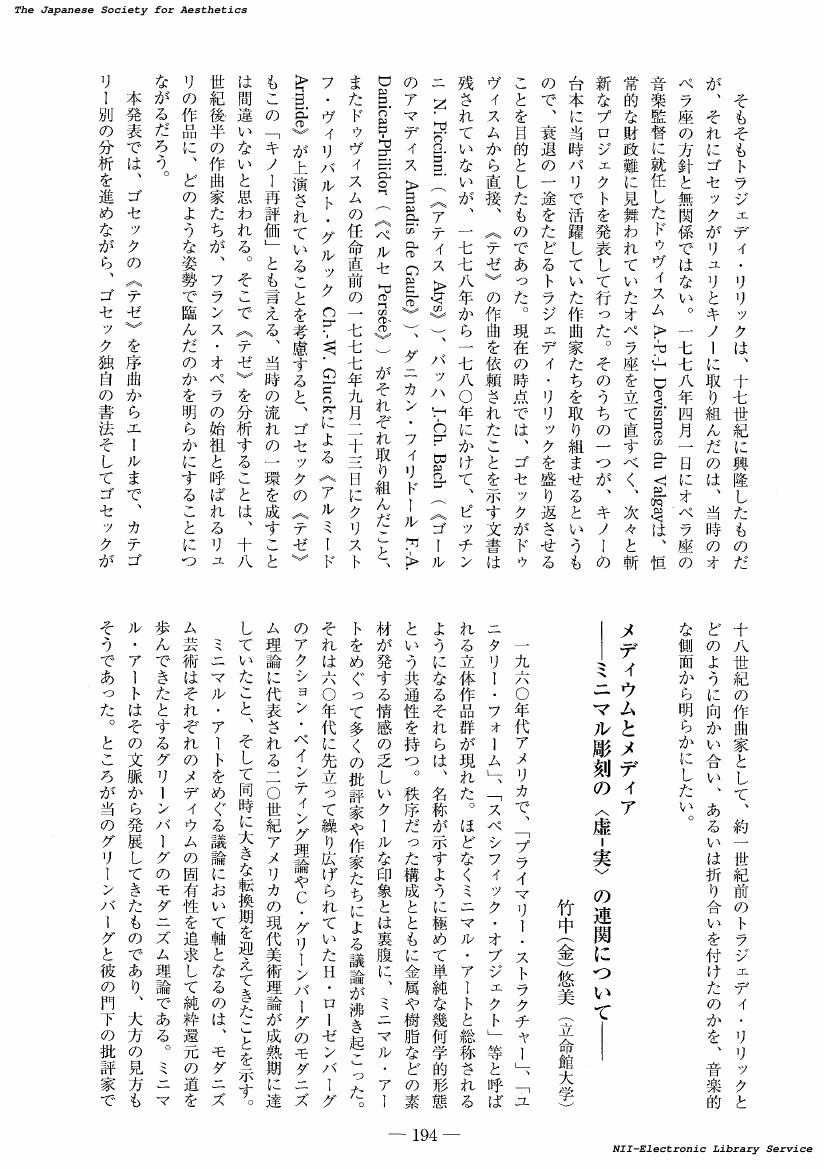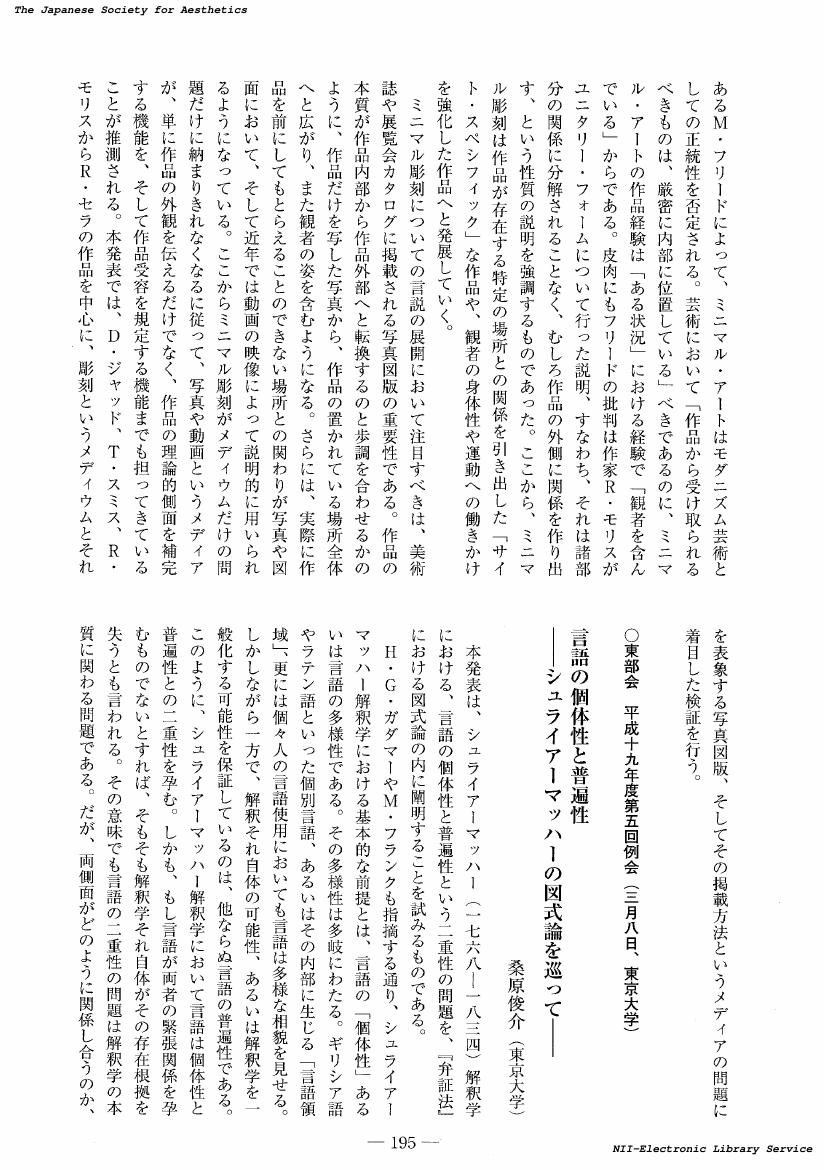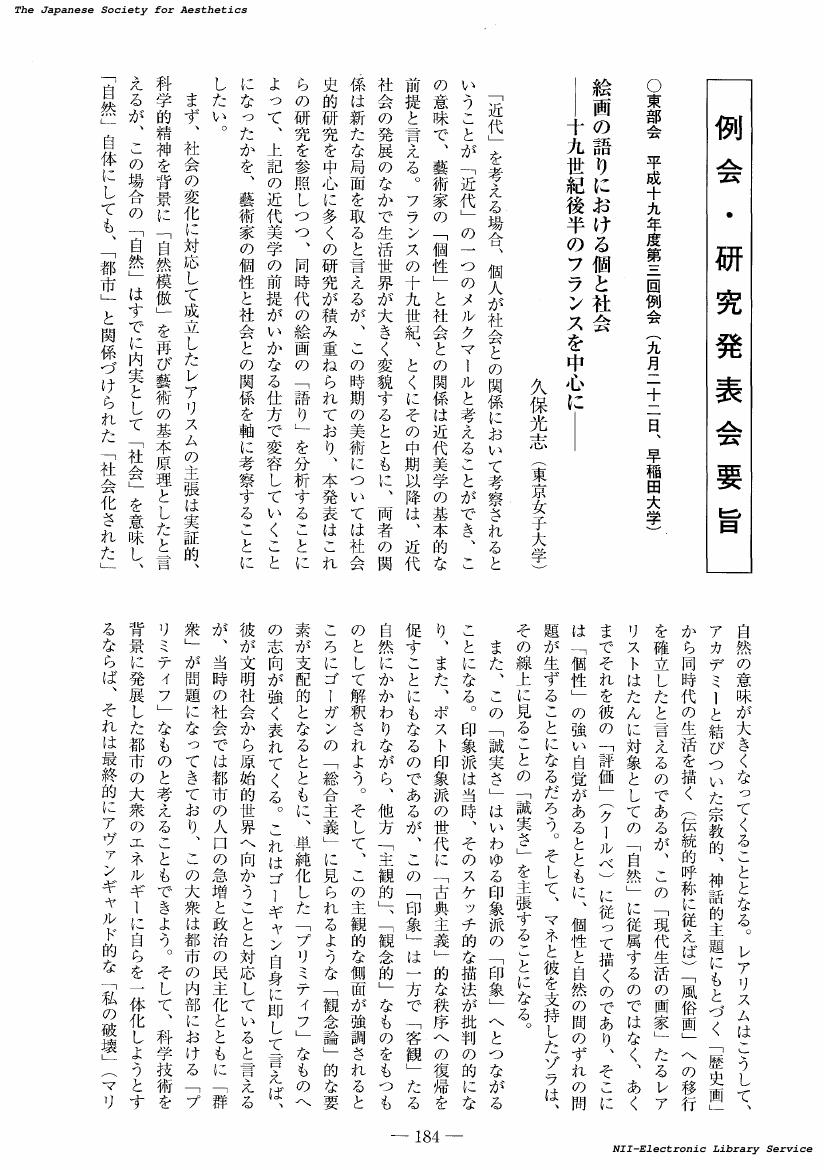1 0 0 0 OA アンシャン・レジーム末期フランスのトラジェディ・リリックの様相 : F.-J.ゴセックの《テゼThesee》(一七八二年)を例に(西部会第二六七回研究発表会,例会・研究発表会要旨)
- 著者
- 坂手 佳絵
- 出版者
- 美学会
- 雑誌
- 美学 (ISSN:05200962)
- 巻号頁・発行日
- vol.59, no.1, pp.193-194, 2008-06-30 (Released:2017-05-22)
- 著者
- 竹中(金) 悠美
- 出版者
- 美学会
- 雑誌
- 美学 (ISSN:05200962)
- 巻号頁・発行日
- vol.59, no.1, pp.194-195, 2008-06-30 (Released:2017-05-22)
- 著者
- 桑原 俊介
- 出版者
- 美学会
- 雑誌
- 美学 (ISSN:05200962)
- 巻号頁・発行日
- vol.59, no.1, pp.195-196, 2008-06-30 (Released:2017-05-22)
1 0 0 0 OA J=S・シャルダンの静物画におけるエスキースの影響
- 著者
- 宮崎 匠
- 出版者
- 美学会
- 雑誌
- 美学 (ISSN:05200962)
- 巻号頁・発行日
- vol.59, no.1, pp.113-126, 2008-06-30 (Released:2017-05-22)
Les natures mortes de Jean-Simeon Chardin (1699-1779) etaient tres admirees au Salon, a la fois pour la facilite de leur execution et pour le refus des details. Et ce alors meme que, jusqu'a cette epoque, presque tous les peintres de natures mortes representaient tous les details de motifs avec le plus grand soin. Le but du present essai est d'eclairer l'influence de l'esquisse, de la premiere pensee du tableau, sur l'execution si particuliere des natures mortes de Chardin. Au XVIIIe siecle un nombre croissant d'amateurs et de connaisseurs entourant Chardin, comme Denis Diderot, admiraient les peintures de genres classees au bas de la hierarchie des genres, et parmi elles les natures mortes de Chardin. En outre, ils les estimaient davantage pour l'execution que pour la valeur des motifs peints. L'analyse d'exemples precis permet de degager des ressemblances entre l'execution des natures mortes par Chardin et celle des esquisses que de plus en plus de contemporains admiraient. Jusqu'a l'epoque ou il commenca a presenter ses natures mortes au Salon, Chardin put prendre conscience de l'importance de l'esquisse, parce qu'il en executai beaucoup, en collectionnait et en parlait meme au Salon.
1 0 0 0 OA イタリア合理主義建築運動における詩学と修辞 : エドアルド・ペルシコと近代の葛藤
- 著者
- 鯖江 秀樹
- 出版者
- 美学会
- 雑誌
- 美学 (ISSN:05200962)
- 巻号頁・発行日
- vol.59, no.1, pp.127-139, 2008-06-30 (Released:2017-05-22)
This paper aims at investigating the peculiar aspects of Italian architectural culture under the fascist regime. Edoardo Persico, the most important critic of architecture between the two wars, recognized well that political powers and architecture crossed on the critical discourse. From this point of view, he defined the short history of this Italian movement as a process from 'europeismo' to 'romanita', and to 'mediterraneita'. These notions do not imply the supremacy of Italian ethic and nation, but demonstrate that young architects, who had been eager to introduce European modern building styles into their own country, was subordinated to political requests of fascism. Yet it was more important for Persico to reveal the rhetorical mechanism that obstructed the European artistic taste ('gusto europeo') and also disguised the Italian one ('gusto italiano') as they were. Hence his analysis of a lot of reviews appeared on the catalogues or magazines proved the diversity of the modern culture. Persico was the only writer that could describe the whole space of critical discourse as a matrix of fascist cultures with some paradoxical characters.
1 0 0 0 OA 「貧しさ」の内と外 : 「アルテ・ポーヴェラ」の領域に関する考察
- 著者
- 池野 絢子
- 出版者
- 美学会
- 雑誌
- 美学 (ISSN:05200962)
- 巻号頁・発行日
- vol.59, no.1, pp.140-153, 2008-06-30 (Released:2017-05-22)
This research is going to talk about the formation of 'Arte povera' as an artistic movement. Today, Arte povera is well-known all over the world as that which used 'poor' materials, such as woods, papers, coals, etc. Although this definition does not always accord with the works in respect of materials and concepts, that critical term 'povera' has succeeded in grouping up the various artists. In fact 'povera' is so ambiguous term that we can do nothing but refer to the text of a critic, Germano Celant, who named this movement. But it can be thought that between the critical discourses and the diverse works, there should be essential difference. Making it clear, this text will study from following three perspectives; the strategy of Celant, contradiction between his rhetoric and acts of artists, and problem with historicization and reception of 'Arte povera.' Through these analyses, it is aimed to show what is included in and what is excluded from the territory of 'Arte povera' along its history.
- 著者
- 小河原 あや
- 出版者
- 美学会
- 雑誌
- 美学 (ISSN:05200962)
- 巻号頁・発行日
- vol.59, no.1, pp.154-166, 2008-06-30 (Released:2017-05-22)
Jean Rouch advocated "cinema-verite" because he considered narrative cinema as the best way to show truth. In his film La Pyramide humaine (1961), some black African students and some white French students at a Cote-d'Ivoire high school improvise according to a general story line in which they make friends with one another. Rouch, following his performers with the camera in his hand, provokes them into action and storytelling. He engages in storytelling as an accomplice. In the classical cinema, characters are in the image, while the camera/director stays outside. Within this framework what the character sees is shown to be equal with what the camera/director sees. According to Deleuze, this not only presents the model of truth but also establishes the identity of the character seen and the one who sees. But in La Pyramide humaine, the camera/director is involved in the image. This precludes the equation, and, consequently, the established truth as well as the identity of characters. In this way, the students become others. "I is another" is a false proposition, but it enables them to tell a story. It has the power to create-to create a truth. Such creativity is what Rouch aimed for in his cinema.
- 著者
- 久保 光志
- 出版者
- 美学会
- 雑誌
- 美学 (ISSN:05200962)
- 巻号頁・発行日
- vol.59, no.1, pp.184-185, 2008-06-30 (Released:2017-05-22)
- 著者
- 丹尾 安典
- 出版者
- 美学会
- 雑誌
- 美学 (ISSN:05200962)
- 巻号頁・発行日
- vol.59, no.1, pp.185-186, 2008-06-30 (Released:2017-05-22)
- 著者
- 武田 宙也
- 出版者
- 美学会
- 雑誌
- 美学 (ISSN:05200962)
- 巻号頁・発行日
- vol.59, no.1, pp.186, 2008-06-30 (Released:2017-05-22)
- 著者
- 前田 茂
- 出版者
- 美学会
- 雑誌
- 美学 (ISSN:05200962)
- 巻号頁・発行日
- vol.59, no.1, pp.186-188, 2008-06-30 (Released:2017-05-22)
1 0 0 0 OA 感性的営為としての旅 : 観光美学の構築に向けて
- 著者
- 津上 英輔
- 出版者
- 美学会
- 雑誌
- 美学 (ISSN:05200962)
- 巻号頁・発行日
- vol.59, no.1, pp.2-14, 2008-06-30 (Released:2017-05-22)
Tourism is a travel for pleasure, especially for the pleasure of seeing. Baumgarten in his Aesthetica identified beauty as "perfection of sense perception, as such". This can be paraphrased as a state of our mind in which we look in order to look (or listen in order to listen), with pleasure and without having it hindered by anything external or taken over by intellectual cognition. Since tourism meets these conditions, it qualifies as the pursuit of beauty. Analysis of tourist activities in photographing, gastronomy and "consumption" shows that photography, tourism-oriented culinary establishments and admission fees mediate between the tourist and the object visited by making the latter appropriate for the former's aesthetic experience. Aesthetics of tourism is thus both possible and necessary as a bridge between aesthetics and tourism research. Contributions expected from this new field of research include applying Kant's argument of disinterestedness against the current tourism research's uncritical conception of tourists' "consumption" of tourist resources and enhancing, through historical researches on ideal beauty sought by tourists of each period, aesthetics' knowledge of the background against which past philosophers presented their theories of beauty and art.
1 0 0 0 OA ジョルジュ・バタイユにおける「呪術的芸術」について
- 著者
- 荻野 厚志
- 出版者
- 美学会
- 雑誌
- 美学 (ISSN:05200962)
- 巻号頁・発行日
- vol.59, no.1, pp.15-28, 2008-06-30 (Released:2017-05-22)
Dans Lascaux ou la naissance de l'art (1955), Georges Bataille se heurte a une aporie de l'art prehistorique, en y trouvant l'essence de magie: il lui fallut admettre son cote utile, alors qu'il considerait l'art en general comme inutile. Cette aporie tient a l'ambiguite meme de l'<<art magique>>, ambiguite qui caracterise l'esthetique anthro-pologique de Bataille, dont la naissance releve du travail qui se lie a calcul interesse et a l'intention efficace. Mais, pour Bataille, l'intention magique doit etre depassee par l'operation qui fait participer les hommes a la realite sensible ou bien au sacre par le jeu. Bataille trouve les signes de l'operation dans l'<<aveugle surete>> qui compose l'ensemble magnifique de la frise de Lascaux, et dans l'expression de l'<<enchevetrement>>. Il nous amene a ignorer la necessite materielle au milieu de cette realite sensible, a la faveur de la volonte de merveille qui communique avec nous. Etrangere a l'intention prealable et efficace, cette realite se caracterise par l'essence ephemere: l'operation qui ouvre cette realite veut dire la creation d'un monde, il s'agit de chaque geste recommence au moment de <<genie>>. Ce que Bataille presente est l'oeuvre d'art qui n'a pas de sens de decoration durable. Nous pouvons conclure donc que l'<<art magique>> est la survivance miraculeuse des gestes ephemeres.
1 0 0 0 OA Haptiqueとは何か : 『感覚の論理』を中心としたドゥルーズの感覚論
- 著者
- 太田 純貴
- 出版者
- 美学会
- 雑誌
- 美学 (ISSN:05200962)
- 巻号頁・発行日
- vol.59, no.1, pp.29-42, 2008-06-30 (Released:2017-05-22)
In his work entitled, Francis Bacon: Logique de la sensation (1981), Gilles Deleuze develops his theory of sensation by considering works by the painter Francis Bacon. The concept of the "haptic (haptique)" plays an important role in Deleuze's analysis of Bacon's paintings. The concept derives from the word "haptic ("taktisch" or "haptisch") as discussed by Alois Riegl. Deleuze captures Riegl's idea of the haptic as opposed to the optic, and extends it in a new direction. The main purpose of my study is to clarify the difference between the ideas of Riegl and Deleuze, and to achieve better understanding of Deleuze's theory of sensation by paying special attention to the haptic. In this paper, I focus on Deleuze's definition of the haptic through examining its use in his works Mille plateaux (1980) and the above-mentioned. Then I discuss the issues of color, the action of the hand, and the "meat," three things which Deleuze saw as crucial to Bacon's technique of painting. In my view, the haptic should be understood in relation to contingency and chance.
1 0 0 0 OA 近世日本の絵画作品における朝鮮通信使の描き方 : 楽隊とその衣装に注目して
- 著者
- 尹 芝惠
- 出版者
- 美学会
- 雑誌
- 美学 (ISSN:05200962)
- 巻号頁・発行日
- vol.59, no.1, pp.57-70, 2008-06-30 (Released:2017-05-22)
During the Edo period, the Korean embassy paid 12 courtesy visits to the Tokugawa shogunate. These visit brought about something new in Japanese art. First, the Korean people and their procession resulted in a new form of expression that displayed a kind of exoticism. Second, these visits led to an exchange between Japanese and Korean artists on their views regarding techniques and styles. In this paper, I illustrate the process of the change in the depiction of Korean people in Japanese art. In particular, I focus on the change in the representation of the marching band that attended the embassy. The members of the marching band wore two kinds of attires. The first was a red robe and a hat with plumes and the second, a blue robe and a cap with a red tassel. Although the uniforms of the marching band, as depicted in the works of Ukiyoe painters, were unrealistic, they are not yet become exotic. However, with the passage of time, the uniforms were reproduced in the cos-tume parades and portrayed rather exotically by the Ukiyoe painters. Such portrayal was unreal. In those days, however, the Japanese people regarded and treated the Koreans as foreigners.
1 0 0 0 OA 一九三九年「伯林日本古美術展覧会」と報道 : 日本美術の評価と展覧会の意図をめぐって
- 著者
- 安松 みゆき
- 出版者
- 美学会
- 雑誌
- 美学 (ISSN:05200962)
- 巻号頁・発行日
- vol.59, no.1, pp.71-84, 2008-06-30 (Released:2017-05-22)
In 1939 wurde die Ausstellung altjapanischer Kunst in Berlin verangestaltet, eine der grossten Ausstellungen von der japanischen Kunst in Europa. In dieser Ausstellung gehorten 94 Werke unter die 126 ausgestellten Objekte zu den staatlichen Kunstdenkmalern von Japan. Aber die politische Situation unter der Nazi-Regierung warf Schatten auf diese Ausstellung. Trotz der seltenen Bedeutung im Kunstaustausch ist sie sowohl in Deutschland als auch in Japan fast Vergessenheit geraten. Seit 1999 untersuche ich uber diese Ausstellung und ihre Hintergrunde der Realisierung. Dieser Beitrag versucht, durch die damaligen Presseberichten, Nachlichtsfilme und sonstigen Quellen die Umstande dieser Ausstellung ausfuhrlicher zu erfassn. Man gelangt zu dem Ergebnis, dass die Materialien die bemerkenswerten Widerspruche und Unterschiede in Haltung und Absicht der Mitspieler dieser Ausstellung zeigen. Das ist: 1) Widerspruch zwischen den japanischen und deutschen Presseberichten uber die Hitlers Interesse an der japanischen Kunst; 2) Die Schatzung der japanischen Kunst und nicht eindeutige Haltung der deutschen Presseberichten zur "Entaltete Kunst", die sie fur die Schatzung der japanischen Kunst herangezogen haben; 3) Schatzung von Ukiyoe und Malerei bzw. Skulptur von den japanischen und deutschen Kunsthistoriker und Politiker.
- 著者
- 門田 彩
- 出版者
- 美学会
- 雑誌
- 美学 (ISSN:05200962)
- 巻号頁・発行日
- vol.59, no.1, pp.85-98, 2008-06-30 (Released:2017-05-22)
In this paper, I investigate El Greco's St. Ildefonso, currently placed at the Chapel of the Hospital of Charity in Illescas. This was painted in his most prolific stage, around 1600. Until recently the details of the commission issued to El Greco have not been obvious. Here, I present a tentative plan concerning the ditails of the commission of St Ildefonso, examining the relationship between El Greco and Salazar de Mendoza, a patron of El Greco. First, I focus on how St. Ildefonso is depicted as a Church Father, or author/scholar figure, which differs from the general representation of St. Ildefonso which portrays him receiving the chasuble, or dressed as an archbishop. I demonstrate how that El Greco's Ildefonso resembles the figure of St. Jerome in his study and I examine the description on St. Jerome and St. Ildefonso in Mendoza's work El Glorioso San Ildefonso…(1618), thus adding evidence for the likelihood of an influence from Mendoza. Moreover, I suggest a close connection between Charity and Mendoza. This is evident from the fact that El Greco and Charity both signed a contract for the retable at the Hospital Tavera, of which Mendoza was administrator. The goal of this paper is to present the details of the commission of St. Ildefonso, considering the intervention of Mendoza, an Toledan.
- 著者
- 諸星 妙
- 出版者
- 美学会
- 雑誌
- 美学 (ISSN:05200962)
- 巻号頁・発行日
- vol.59, no.1, pp.99-112, 2008-06-30 (Released:2017-05-22)
This paper examines the opening and the function of the gesture of Cristobal Suarez de Ribera in his portrait by Velazquez. The portrait was painted in 1620, that is two years after the subject's death, and was placed above the tomb of Cristobal Suarez in the Chapel of San Hermenegildo in Seville, which he had founded from 1606 to 1616. As was the custom for funerary sculptures, he is shown kneeling in the attitude of a prayer. However he is pointing towards the main altar which contains a polychrome statue of San Hermenegildo by Martinez Montanes. This gesture is exceptional for a funerary portraiture, which leads us to consider that the portrait performs a specific function in the Chapel. In this point, showing how the portrait was hung in the Chapel in the 17th century, I point out that Suarez in this portrait plays a role similar to the intercession. According to the documents, Suarez was known as a leading figure in the veneration of San Hermenegildo at that time, which makes us consider that Velazquez painted the portrait in a peculiar manner so that Suarez could seem to be playing a role of mediator between the members of the Confraternity of San Hermenegildo and the statue of the saint in the main altar.
1 0 0 0 OA シュライアマハーの言明「すべての人は芸術家である」 : 「近代美学」の超克にはたした倫理学概念Besonnenheitの役割について(西部会第二六四回研究発表会,例会・研究発表会要旨)
- 著者
- 岡林 洋
- 出版者
- 美学会
- 雑誌
- 美学 (ISSN:05200962)
- 巻号頁・発行日
- vol.58, no.3, pp.172-174, 2007-12-31 (Released:2017-05-22)
- 著者
- 安川 智子
- 出版者
- 美学会
- 雑誌
- 美学 (ISSN:05200962)
- 巻号頁・発行日
- vol.58, no.3, pp.162, 2007-12-31 (Released:2017-05-22)








